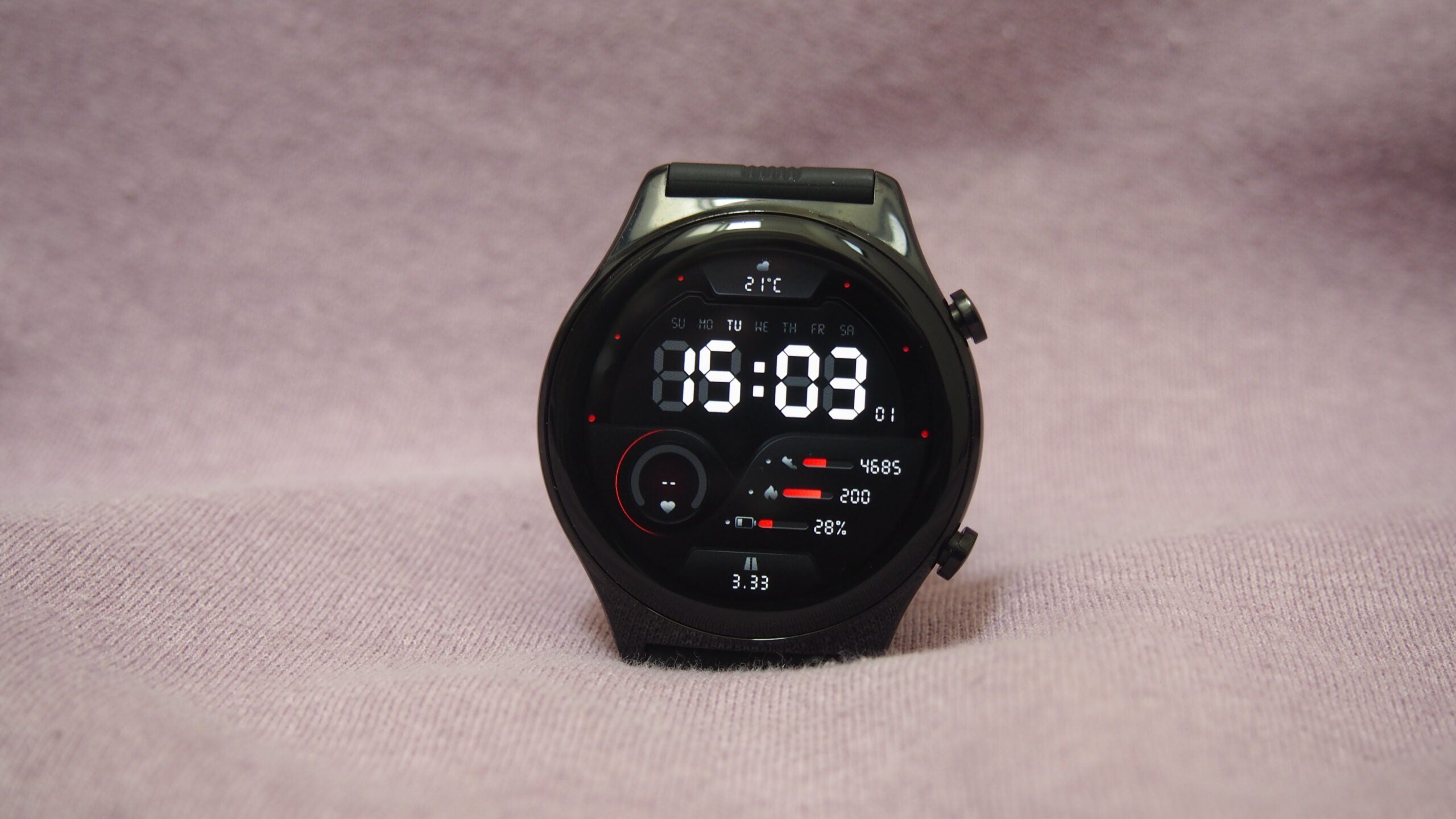The Honor Watch GS 3 is a better sports and fitness watch than smartwatch, offering decent battery life and an attractive design and display to match. If you’re on the lookout for the best smartwatch at this price, though, there are stronger options available right now.
Pros
- Vibrant screen
- Strong sports and fitness tracking
- Good battery life
Cons
- Slightly sluggish software
- Honor Health app is a work in progress
- iOS support isn’t available yet
-
Resistant to water5ATM water resistance so can be used for swimming -
ConnectivityBuilt-in GPS, among other features -
Long endurance14-day battery life. means you won’t need a charger handy
Introduction
With the Watch GS 3, Honor promises to put a sleek, stylish smartwatch on your wrist, minus the big price tag.
The Android-friendly watch, which will apparently work with iPhones at some point, comes in at under £200, offering a decent selection of features for that mid-range price. You get an AMOLED display, the promise of accurate outdoor tracking, and a bucket-load of sports modes. There’s a music player, too, actionable notifications and battery life that can go for weeks.
It’s a smartwatch that still feels very “Huawei”, despite the Chinese tech giant selling off the brand back in 2021. Things are becoming competitive at this end of the smartwatch market, so does the Honor GS 3 do enough to impress?
Design and Screen
- Vibrant AMOLED screen
- Stainless steel case
- 22mm straps
- Waterproof up to 50 metres
The Honor GS 3 doesn’t reinvent the wheel as far as smartwatch design is concerned, but what it does deliver feels well built and comfortable to wear 24/7. In addition, you get a pretty impressive display.
The 45mm-sized case is made from metal and has a plastic rear, while the 22mm strap is removable and super-easy to switch out. Honor offers the GS 3 in three colours: Midnight Black (pictured), Ocean Blue and Classic Gold. The latter two come with the Napa leather strap as opposed to the more exercise-friendly silicone one on the black model I was testing.
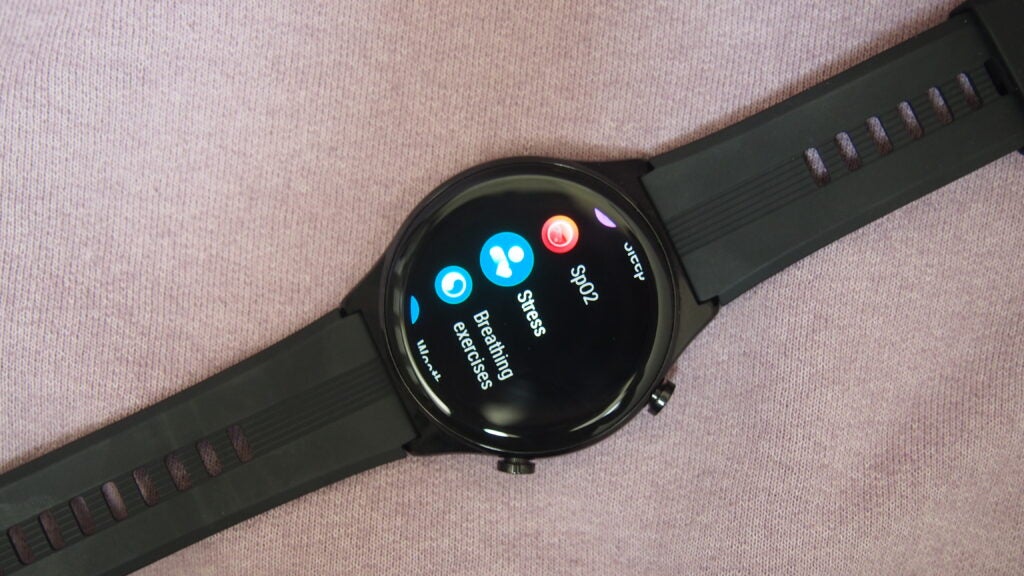
Design-wise, Honor plays it safe then, with the screen clearly the standout feature. It’s a slightly curved 1.43-inch, 466 x 466 resolution AMOLED touchscreen that’s surrounded by a slim black bezel. Honor does a decent job of pushing the bezel into the background when it’s matched up with most of the preloaded watch faces.
This isn’t an always-on display, and there doesn’t appear to be raise-to-wake gesture support here, either. As such, you’ll need to press one of the two physical buttons on the side of the watch’s case to wake it, which isn’t ideal.
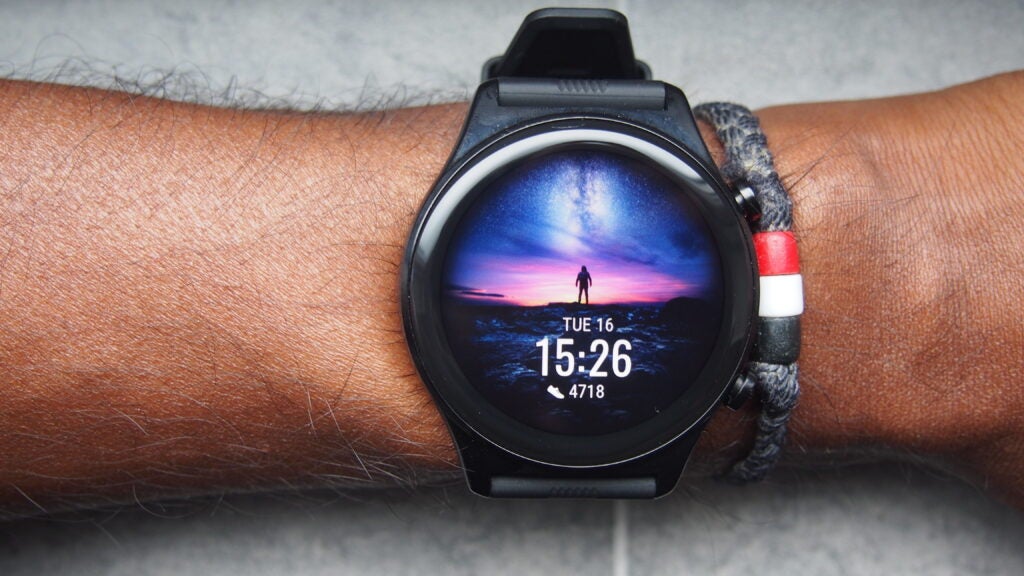
The screen is exceptionally bright and accurate, though, with the kind of pleasing deep blacks you’d associate with a quality AMOLED screen. That slightly curved design elevates the overall look of the watch, too – although those looking for the sleekest version of the watch are advised to opt for the slightly more expensive blue or gold models.
If you want a watch that can accompany you on a swim, you’re good to do that here. The Honor Watch GS 3 carries a 5ATM water-resistant rating, which means it’s safe to be submerged in water up to 50 metres in depth.
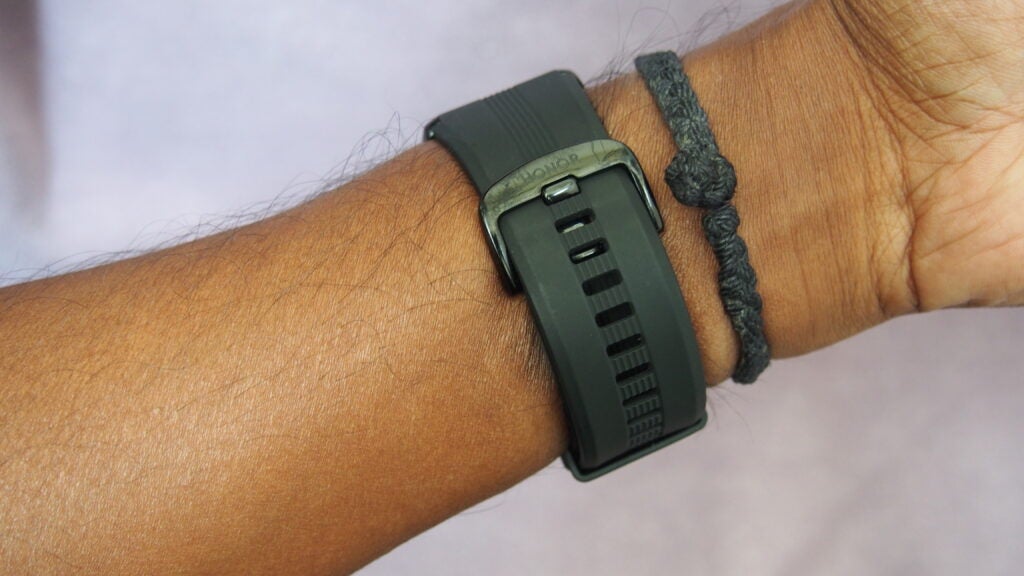
Features and Performance
- Android-only support right now
- Honor Health app feels familiar
- Built-in music player
Honor may no longer be part of Huawei, but the watch software appears to tell a different story. Honor doesn’t detail the operating system on which the GS 3 runs, but it’s clearly a proprietary one that’s very Huawei Harmony OS and Lite OS in presentation and experience.
It currently only works with Android phones; iOS support will be added as an OTA update, although currently there are no details about when that will happen. You’ll need the Honor Health smartphone app to pair, sync and tinker with the watch’s settings and – surprise, surprise – this looks rather like Huawei’s Health app.
Honor doesn’t divulge any processor details here, either, but it doesn’t take too many swipes of that screen to discover it isn’t super-slick. There’s some minimal lag, which doesn’t massively hamper the experience of using it day-to-day, but it is noticeable.
There are a nice collection of static watch faces available, with more you can install and sync from the Health app. Notification support is well optimised to the screen and offers the ability to send quick replies to messages – or a response to an incoming call on your phone that you don’t want to deal with at that moment. However, the list of supported apps from which you can receive notifications didn’t seem all that extensive through testing.
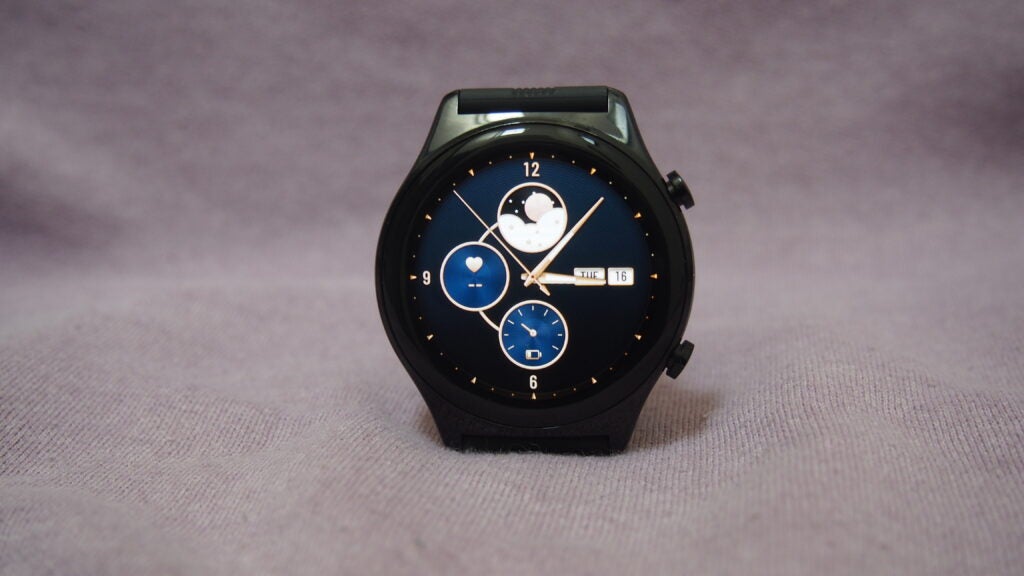
Along with music playback controls, which don’t hugely differ from previous Honor watches, the GS 3 also includes a music player, with part of the onboard 4GB of storage available for storing your own music. Much like Huawei’s watches, you’re only able to sync music you own, and it needs to be on your phone to do that. If you want to sync over playlists from services such as Spotify or Deezer, you’re out of luck here.
Honor does include some nicely detailed weather forecasts and some standard features such as being able to set alarms, timers and a stopwatch function. The Find My Phone mode is useful, as is the Torch mode, which turns the screen into a more vibrant and bright white light. You can’t make payments with the Watch GS 3, nor do you get rich third-party app support or a voice-based smart assistant – and that’s despite the presence of a microphone and speaker.
Overall, it’s a smartwatch experience that feels good enough. However, around this price it’s possible to find smartwatches that offer a more comprehensive package – and, crucially, models that do so without the slight lag you’ll encounter using the GS 3.
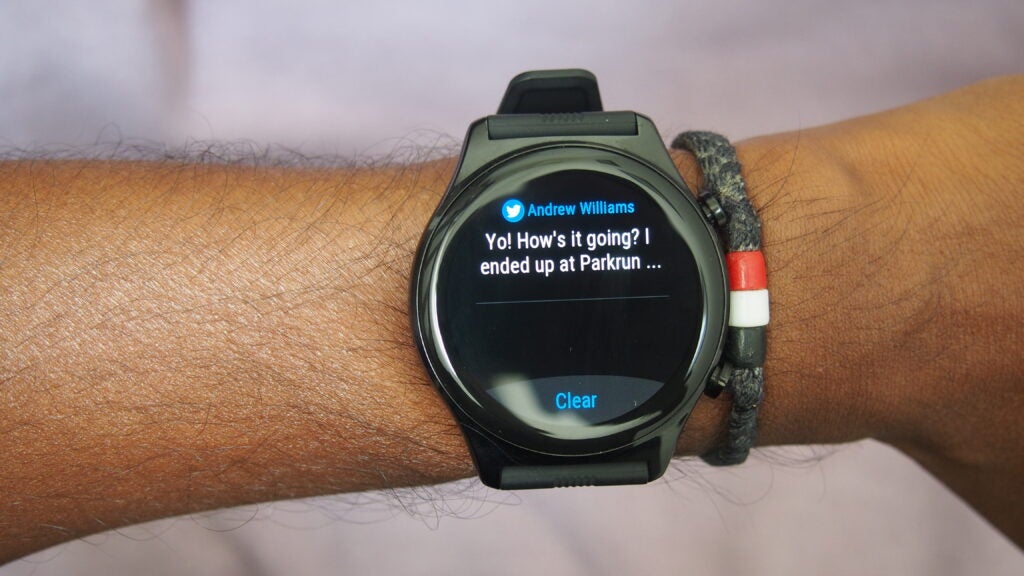
Fitness Tracking
- Over 100 workout modes
- Dual-band GPS
- Heart rate and SpO2 monitoring
The GS 3 covers most of the areas you’d expect for tracking activity, whether that’s daily step counts, tracking runs or swims, and monitoring your sleep time too.
According to Honor, the optical heart rate sensor that features in the Watch GS 3 benefits from an eight-channel heart rate AI engine that delivers an overall heart rate accuracy of over 97%. It’s also capable of continuously capturing blood oxygen data and taking on-the-spot measurements if you need to check blood oxygen levels throughout the day. That optical heart rate sensor also unlocks the ability to monitor stress continuously.
Head outside and you’ll be able to make use of the device’s compass and air pressure sensors, along with built-in GPS; it also includes a dual-frequency GNSS mode. This is something we’ve seen before on watches from Huawei, Amazfit and Coros, and is designed to improve the accuracy of outdoor exercise tracking for activities such as running and cycling in areas where grabbing a reliable signal from supported satellite systems can be a struggle.
When it’s time to start tracking, simply hit the bottom physical button or jump into the workout screen, which looks identical to Huawei’s workout screen. There are over 100 sports modes supported here, and also included are both running courses and fitness courses that have featured on Huawei’s smartwatches, with the latter offering animations to guide users on how to correctly perform exercises.
For runs, you can set target goals, receive reminders when you hit a certain heart rate, for instance, and set up automatic or manual splits. I put the Watch GS 3 up against the very impressive multi-band mode on Garmin’s Epix 2 for accuracy, finding it fell a bit short on distance tracking and clocking me in at a slower average pace. Heart tracking accuracy on steady paced runs was generally fine against a heart rate monitor chest strap, although for some hilly interval times, the Watch GS 3 was 4-5bpm off a chest strap for both average and maximum heart rate readings.
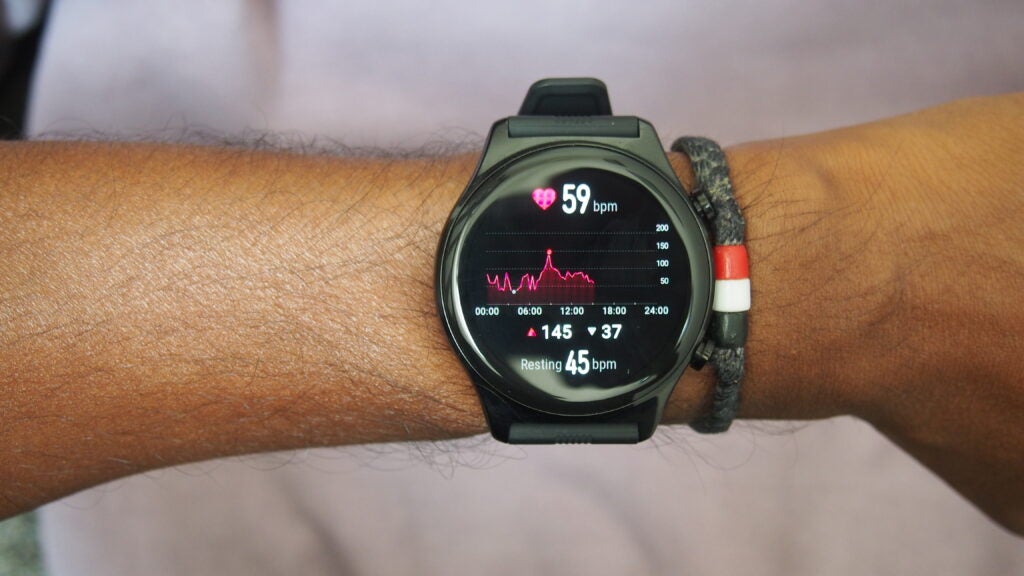
I took the Watch GS 3 into the pool for a swim and on an indoor rower to find data accuracy was very good in general, which shows it has all the characteristics of a more than competent smartwatch for tracking exercise.
Honor also provides additional training and recovery insights, largely fuelled by tracked workouts and metrics such as your heart rate. You can see suggested recovery time, training load and VO2 max scores, but these felt more like loose guidance than anything to actually live by when making decisions about your training.
If you’ll primarily be using the device as a fitness and sleep tracker, then it performs fine in both areas. There’s a dedicated watch widget to display daily activity tracking progress and step tracking. Up against step tracking on the Oura Ring 3 smart ring, daily totals were close. For sleep, it offered similar core data to Oura’s strong sleep tracking support. Sleep duration typically was 30 minutes longer on the GS 3, with sleep stage breakdowns and sleep scores similar. It was the same story for capturing breathing during that sleep time.
If you care about your heart health, I found resting heart rate and low heart rate data to be in line with data captured on the Oura and the reliable continuous heart rate tracking of Garmin’s Epix 2. It meant that features such as stress tracking, powered by data captured by the optical sensor, were useful, with a dedicated screen clearly displaying stressful and calm parts of your day. Average blood oxygen levels were typically 1-2% out from a pulse oximeter and the SpO2 sensor on the Oura, staying in a range that can offer reliable insight.
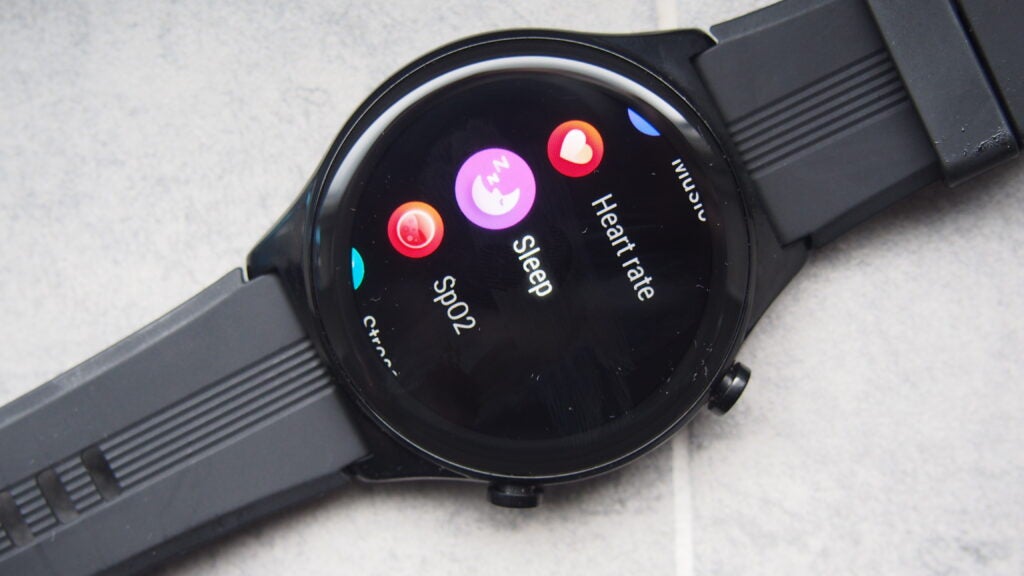
Battery Life
- Up to 14 days of battery life
- Five-minute charge gives you a day of play
- 30 hours of GPS battery life
The Honor Watch GS 3 is a smartwatch that promises weeks of battery life – and can deliver just that. Under heavy use, where you’re making use of continuous blood oxygen and heart rate monitoring, battery life is more like a week; but overall, battery life performance is solid.
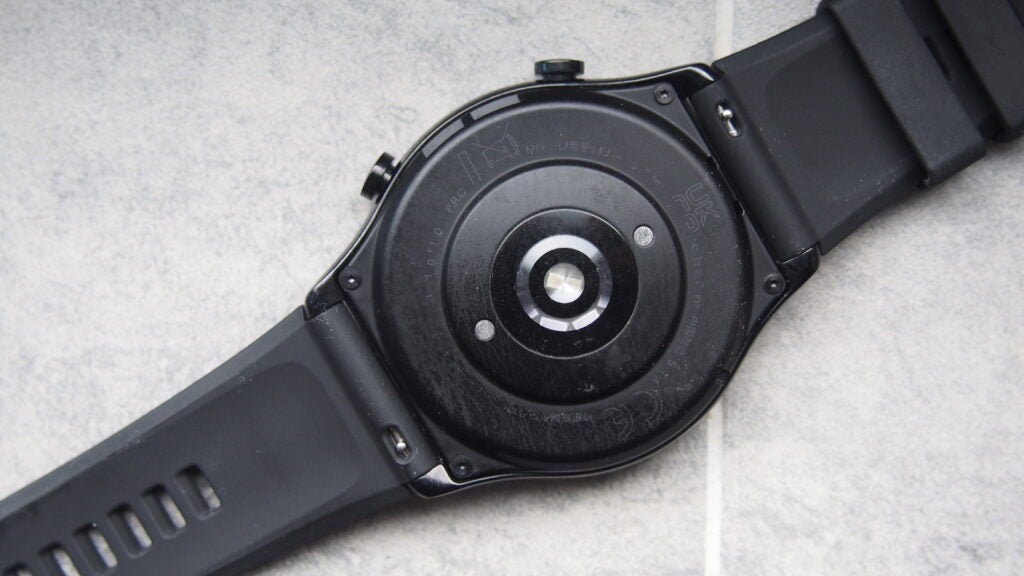
There isn’t a huge daily drop-off when it comes to day-to-day use, and battery consumption with GPS for outdoor tracking wasn’t as severe as I’d feared, with the Watch GS 3 capable of replicating the performance of Huawei’s watches on that front. That claimed 30 hours of GPS battery life feels absolutely possible.
In addition, Honor does also offer some quick-charge, delivering a day’s play from a five-minute top-up. The watch uses a pretty familiar puck-style charging cradle and cable that clips securely onto the rear of the device.
Latest deals
Should you buy it?
If you want a smartwatch with a strong health and fitness focus The GS 3 performed pretty well from both an activity and sports-tracking point of view, and these would be key reasons to consider opting for this device.
You want the best smartwatch at this price While it’s pretty good on the watch, the Honor Health app isn’t the slickest; it’s missing some obvious software elements and that slightly sluggish software doesn’t help matters, either.
Final Thoughts
The Honor Watch GS 3 is a surprisingly competent smartwatch, which definitely has a strong health and fitness focus – and it’s in those areas it impresses most.
Is it the best smartwatch? No. However, it remains another decent option for Android users – and, if Honor can refine the software and bring in some richer smartwatch features, it could rival stronger alternatives from Huawei and Amazfit at this price.
How we test
We thoroughly test every smartwatch we review. We use industry standard testing to compare features properly and we use the watch as our main device over the review period. We’ll always tell you what we find and we never, ever, accept money to review a product.
Worn as our main smartwatch during the testing period
Heart rate data compared against dedicated heart rate devices
Side-by-side GPS comparison with our best scoring smartwatches
FAQs
Currently, the Honor Watch GS 3 is only compatible with Android smartphones, with iOS support stated to land at a later date.
You can take calls from the Watch GS 3, as long as the smartwatch is paired with your phone over Bluetooth.
Trusted Reviews test data
Jargon buster
OLED and AMOLED
Types of displays that use self-lighting pixels to provide greater contrast and more vibrant colours than a typical LCD display, as well as sharper blacks.
GPS
An abbreviation of the Global Positioning System, which uses satellite communication to pinpoint your location. Some smartwatches are able to achieve this communication without the use of a smartphone.
The Honor Watch GS 3 is a better sports and fitness watch than smartwatch, offering decent battery life and an attractive design and display to match. If you’re on the lookout for the best smartwatch at this price, though, there are stronger options available right now.
Pros
- Vibrant screen
- Strong sports and fitness tracking
- Good battery life
Cons
- Slightly sluggish software
- Honor Health app is a work in progress
- iOS support isn’t available yet
-
Resistant to water5ATM water resistance so can be used for swimming -
ConnectivityBuilt-in GPS, among other features -
Long endurance14-day battery life. means you won’t need a charger handy
Introduction
With the Watch GS 3, Honor promises to put a sleek, stylish smartwatch on your wrist, minus the big price tag.
The Android-friendly watch, which will apparently work with iPhones at some point, comes in at under £200, offering a decent selection of features for that mid-range price. You get an AMOLED display, the promise of accurate outdoor tracking, and a bucket-load of sports modes. There’s a music player, too, actionable notifications and battery life that can go for weeks.
It’s a smartwatch that still feels very “Huawei”, despite the Chinese tech giant selling off the brand back in 2021. Things are becoming competitive at this end of the smartwatch market, so does the Honor GS 3 do enough to impress?
Design and Screen
- Vibrant AMOLED screen
- Stainless steel case
- 22mm straps
- Waterproof up to 50 metres
The Honor GS 3 doesn’t reinvent the wheel as far as smartwatch design is concerned, but what it does deliver feels well built and comfortable to wear 24/7. In addition, you get a pretty impressive display.
The 45mm-sized case is made from metal and has a plastic rear, while the 22mm strap is removable and super-easy to switch out. Honor offers the GS 3 in three colours: Midnight Black (pictured), Ocean Blue and Classic Gold. The latter two come with the Napa leather strap as opposed to the more exercise-friendly silicone one on the black model I was testing.

Design-wise, Honor plays it safe then, with the screen clearly the standout feature. It’s a slightly curved 1.43-inch, 466 x 466 resolution AMOLED touchscreen that’s surrounded by a slim black bezel. Honor does a decent job of pushing the bezel into the background when it’s matched up with most of the preloaded watch faces.
This isn’t an always-on display, and there doesn’t appear to be raise-to-wake gesture support here, either. As such, you’ll need to press one of the two physical buttons on the side of the watch’s case to wake it, which isn’t ideal.

The screen is exceptionally bright and accurate, though, with the kind of pleasing deep blacks you’d associate with a quality AMOLED screen. That slightly curved design elevates the overall look of the watch, too – although those looking for the sleekest version of the watch are advised to opt for the slightly more expensive blue or gold models.
If you want a watch that can accompany you on a swim, you’re good to do that here. The Honor Watch GS 3 carries a 5ATM water-resistant rating, which means it’s safe to be submerged in water up to 50 metres in depth.

Features and Performance
- Android-only support right now
- Honor Health app feels familiar
- Built-in music player
Honor may no longer be part of Huawei, but the watch software appears to tell a different story. Honor doesn’t detail the operating system on which the GS 3 runs, but it’s clearly a proprietary one that’s very Huawei Harmony OS and Lite OS in presentation and experience.
It currently only works with Android phones; iOS support will be added as an OTA update, although currently there are no details about when that will happen. You’ll need the Honor Health smartphone app to pair, sync and tinker with the watch’s settings and – surprise, surprise – this looks rather like Huawei’s Health app.
Honor doesn’t divulge any processor details here, either, but it doesn’t take too many swipes of that screen to discover it isn’t super-slick. There’s some minimal lag, which doesn’t massively hamper the experience of using it day-to-day, but it is noticeable.
There are a nice collection of static watch faces available, with more you can install and sync from the Health app. Notification support is well optimised to the screen and offers the ability to send quick replies to messages – or a response to an incoming call on your phone that you don’t want to deal with at that moment. However, the list of supported apps from which you can receive notifications didn’t seem all that extensive through testing.

Along with music playback controls, which don’t hugely differ from previous Honor watches, the GS 3 also includes a music player, with part of the onboard 4GB of storage available for storing your own music. Much like Huawei’s watches, you’re only able to sync music you own, and it needs to be on your phone to do that. If you want to sync over playlists from services such as Spotify or Deezer, you’re out of luck here.
Honor does include some nicely detailed weather forecasts and some standard features such as being able to set alarms, timers and a stopwatch function. The Find My Phone mode is useful, as is the Torch mode, which turns the screen into a more vibrant and bright white light. You can’t make payments with the Watch GS 3, nor do you get rich third-party app support or a voice-based smart assistant – and that’s despite the presence of a microphone and speaker.
Overall, it’s a smartwatch experience that feels good enough. However, around this price it’s possible to find smartwatches that offer a more comprehensive package – and, crucially, models that do so without the slight lag you’ll encounter using the GS 3.

Fitness Tracking
- Over 100 workout modes
- Dual-band GPS
- Heart rate and SpO2 monitoring
The GS 3 covers most of the areas you’d expect for tracking activity, whether that’s daily step counts, tracking runs or swims, and monitoring your sleep time too.
According to Honor, the optical heart rate sensor that features in the Watch GS 3 benefits from an eight-channel heart rate AI engine that delivers an overall heart rate accuracy of over 97%. It’s also capable of continuously capturing blood oxygen data and taking on-the-spot measurements if you need to check blood oxygen levels throughout the day. That optical heart rate sensor also unlocks the ability to monitor stress continuously.
Head outside and you’ll be able to make use of the device’s compass and air pressure sensors, along with built-in GPS; it also includes a dual-frequency GNSS mode. This is something we’ve seen before on watches from Huawei, Amazfit and Coros, and is designed to improve the accuracy of outdoor exercise tracking for activities such as running and cycling in areas where grabbing a reliable signal from supported satellite systems can be a struggle.
When it’s time to start tracking, simply hit the bottom physical button or jump into the workout screen, which looks identical to Huawei’s workout screen. There are over 100 sports modes supported here, and also included are both running courses and fitness courses that have featured on Huawei’s smartwatches, with the latter offering animations to guide users on how to correctly perform exercises.
For runs, you can set target goals, receive reminders when you hit a certain heart rate, for instance, and set up automatic or manual splits. I put the Watch GS 3 up against the very impressive multi-band mode on Garmin’s Epix 2 for accuracy, finding it fell a bit short on distance tracking and clocking me in at a slower average pace. Heart tracking accuracy on steady paced runs was generally fine against a heart rate monitor chest strap, although for some hilly interval times, the Watch GS 3 was 4-5bpm off a chest strap for both average and maximum heart rate readings.

I took the Watch GS 3 into the pool for a swim and on an indoor rower to find data accuracy was very good in general, which shows it has all the characteristics of a more than competent smartwatch for tracking exercise.
Honor also provides additional training and recovery insights, largely fuelled by tracked workouts and metrics such as your heart rate. You can see suggested recovery time, training load and VO2 max scores, but these felt more like loose guidance than anything to actually live by when making decisions about your training.
If you’ll primarily be using the device as a fitness and sleep tracker, then it performs fine in both areas. There’s a dedicated watch widget to display daily activity tracking progress and step tracking. Up against step tracking on the Oura Ring 3 smart ring, daily totals were close. For sleep, it offered similar core data to Oura’s strong sleep tracking support. Sleep duration typically was 30 minutes longer on the GS 3, with sleep stage breakdowns and sleep scores similar. It was the same story for capturing breathing during that sleep time.
If you care about your heart health, I found resting heart rate and low heart rate data to be in line with data captured on the Oura and the reliable continuous heart rate tracking of Garmin’s Epix 2. It meant that features such as stress tracking, powered by data captured by the optical sensor, were useful, with a dedicated screen clearly displaying stressful and calm parts of your day. Average blood oxygen levels were typically 1-2% out from a pulse oximeter and the SpO2 sensor on the Oura, staying in a range that can offer reliable insight.

Battery Life
- Up to 14 days of battery life
- Five-minute charge gives you a day of play
- 30 hours of GPS battery life
The Honor Watch GS 3 is a smartwatch that promises weeks of battery life – and can deliver just that. Under heavy use, where you’re making use of continuous blood oxygen and heart rate monitoring, battery life is more like a week; but overall, battery life performance is solid.

There isn’t a huge daily drop-off when it comes to day-to-day use, and battery consumption with GPS for outdoor tracking wasn’t as severe as I’d feared, with the Watch GS 3 capable of replicating the performance of Huawei’s watches on that front. That claimed 30 hours of GPS battery life feels absolutely possible.
In addition, Honor does also offer some quick-charge, delivering a day’s play from a five-minute top-up. The watch uses a pretty familiar puck-style charging cradle and cable that clips securely onto the rear of the device.
Latest deals
Should you buy it?
If you want a smartwatch with a strong health and fitness focus The GS 3 performed pretty well from both an activity and sports-tracking point of view, and these would be key reasons to consider opting for this device.
You want the best smartwatch at this price While it’s pretty good on the watch, the Honor Health app isn’t the slickest; it’s missing some obvious software elements and that slightly sluggish software doesn’t help matters, either.
Final Thoughts
The Honor Watch GS 3 is a surprisingly competent smartwatch, which definitely has a strong health and fitness focus – and it’s in those areas it impresses most.
Is it the best smartwatch? No. However, it remains another decent option for Android users – and, if Honor can refine the software and bring in some richer smartwatch features, it could rival stronger alternatives from Huawei and Amazfit at this price.
How we test
We thoroughly test every smartwatch we review. We use industry standard testing to compare features properly and we use the watch as our main device over the review period. We’ll always tell you what we find and we never, ever, accept money to review a product.
Worn as our main smartwatch during the testing period
Heart rate data compared against dedicated heart rate devices
Side-by-side GPS comparison with our best scoring smartwatches
FAQs
Currently, the Honor Watch GS 3 is only compatible with Android smartphones, with iOS support stated to land at a later date.
You can take calls from the Watch GS 3, as long as the smartwatch is paired with your phone over Bluetooth.
Trusted Reviews test data
Jargon buster
OLED and AMOLED
Types of displays that use self-lighting pixels to provide greater contrast and more vibrant colours than a typical LCD display, as well as sharper blacks.
GPS
An abbreviation of the Global Positioning System, which uses satellite communication to pinpoint your location. Some smartwatches are able to achieve this communication without the use of a smartphone.



















